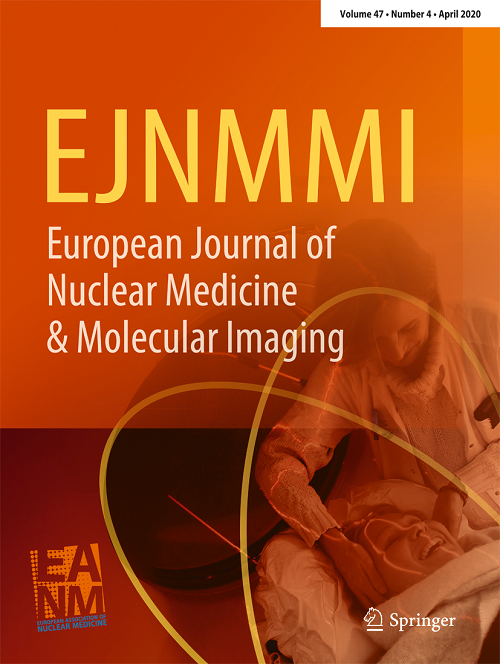基于分子成像的纹状体生物物理变化与儿童自限性癫痫的认知障碍密切相关。
IF 8.6
1区 医学
Q1 RADIOLOGY, NUCLEAR MEDICINE & MEDICAL IMAGING
European Journal of Nuclear Medicine and Molecular Imaging
Pub Date : 2025-07-09
DOI:10.1007/s00259-025-07397-7
引用次数: 0
摘要
目的采用18F-氟脱氧葡萄糖([18F]FDG)正电子发射断层扫描(PET)和结构磁共振成像(sMRI)技术,探讨纹状体在自限性癫痫伴中央颞叶尖峰(SeLECTS)患者认知障碍中的功能作用。方法前瞻性纳入43例select患者(典型24例,非典型19例),均行FDG PET/CT、3D-T1WI MRI及神经心理评估。选取20例颅内外肿瘤患儿作为PET对照组,20例正常儿童作为MRI对照组。通过测量PET图像的标准化摄取值比(SUVR)获得脑区葡萄糖代谢。脑结构改变是通过核磁共振成像测量核体积得出的。通过相关分析探讨糖代谢、脑结构改变与认知功能之间的关系。结果与典型select患者和对照组相比,非典型select患者的智商(IQ)较低。PET图像分析显示,select患者双侧壳核和白质的SUVR明显降低。具体来说,非典型select的双侧壳核和白质的SUVR最低。MRI图像分析显示,非典型select患者左侧壳核和双侧白质体积明显减小,典型select患者左侧白质体积增大。相关分析显示,微囊内SUVR和体积的改变与认知功能障碍有显著相关性。结论本研究首次在影像学上发现非典型和典型select患者的认知功能障碍均与糖代谢和透镜体体积,尤其是苍白质透镜体体积高度相关,为进一步了解select的认知功能障碍提供了依据。本文章由计算机程序翻译,如有差异,请以英文原文为准。
Molecular imaging based biophysical changes of striatum closely associated with cognitive impairment in childhood self-limited epilepsy with centrotemporal spikes.
PURPOSE
This study aimed to investigate the functional role of striatum in cognitive impairment of self-limited epilepsy with centrotemporal spikes (SeLECTS) patients using 18F-fluorodeoxyglucose ([18F]FDG) positron emission tomography (PET) and structural magnetic resonance imaging (sMRI).
METHODS
Forty-three patients with SeLECTS (24 typical and 19 atypical) who underwent [18F]FDG PET/CT, 3D-T1WI MRI and neuropsychological assessment were prospectively enrolled. Twenty children with extracranial tumors and twenty healthy children were included as the PET control and MRI control, respectively. Glucose metabolism of brain regions was obtained by measuring standardized uptake value ratio (SUVR) of PET images. Brain structural alterations were derived from MRI image by measuring nuclei volume. Correlation analysis was performed to investigate the relationship among glucose metabolism, brain structural alterations and cognitive function.
RESULTS
Compared with typical SeLECTS and control group, atypical SeLECTS patients had inferior intelligence quotient (IQ). PET image analysis presented significantly reduced SUVR in bilateral putamen and pallidum of SeLECTS patients. Specifically, atypical SeLECTS had the lowest SUVR of bilateral putamen and pallidum. MRI image analysis showed markedly reduced volume of left putamen and bilateral pallidum in atypical SeLECTS and enlarged volume of left pallidum in typical SeLECTS. Correlation analysis showed that altered SUVR and volume in lenticula were significantly associated with cognitive impairment.
CONCLUSION
This study presented the first imaging findings that cognitive impairment in both atypical and typical SeLECTS patients is highly correlated with glucose metabolism and volume of lenticula, especially in the pallidum, providing further understanding for cognitive impairment of SeLECTS.
求助全文
通过发布文献求助,成功后即可免费获取论文全文。
去求助
来源期刊
CiteScore
15.60
自引率
9.90%
发文量
392
审稿时长
3 months
期刊介绍:
The European Journal of Nuclear Medicine and Molecular Imaging serves as a platform for the exchange of clinical and scientific information within nuclear medicine and related professions. It welcomes international submissions from professionals involved in the functional, metabolic, and molecular investigation of diseases. The journal's coverage spans physics, dosimetry, radiation biology, radiochemistry, and pharmacy, providing high-quality peer review by experts in the field. Known for highly cited and downloaded articles, it ensures global visibility for research work and is part of the EJNMMI journal family.

 求助内容:
求助内容: 应助结果提醒方式:
应助结果提醒方式:


